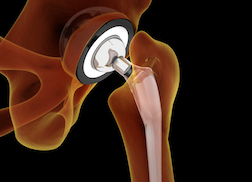 “The problem here is the junction between the femoral head and the femoral stem -- it is a modular connection,” says Ellen Relkin from Weitz & Luxenberg in New York. Relkin is serving as lead counsel in the litigation. “The stems are typically titanium alloys and the heads are cobalt chromium and therein lies the problem.”
“The problem here is the junction between the femoral head and the femoral stem -- it is a modular connection,” says Ellen Relkin from Weitz & Luxenberg in New York. Relkin is serving as lead counsel in the litigation. “The stems are typically titanium alloys and the heads are cobalt chromium and therein lies the problem.”Some of hip implants of this design use a ceramic head. The problems in the current litigation relate only to cobalt chromium heads combined with the titanium stems.
The mixed metal can “fret” and corrode over time with the repeated motion of the hip.
“You have different metals that are interacting at the junction,” says Relkin. “Thousands of people have had these devices implanted. They don’t fail as quickly as the more notorious Stryker Rejuvenator or the ASR. The failures we are seeing are more typically after six, seven, eight years – it takes longer to do its damage.”
Failures are more common among implants with larger femoral heads.
“The medical literature shows that the majority of these types of failures have been in people who had the larger head which is 36 millimeters in size. Although there are some cases with a small head. But people with larger heads are probably more at risk,” says Relkin.
The first sign of trouble may be pain in the hip area. If the corrosion is extensive enough the hip implant may crack.
Corroded Stryker V40s almost always mean elevated cobalt levels.
“Most would have elevated levels of cobalt and chromium levels with cobalt being the more important one. Many of them, if they have MRIs done, you’ll see evidence of tissue or bone damage with pseudo tumors and fluid,” says Relkin. “Some people even get disassociation, which is the worst complication, where the femoral head cracks off because the trunnion (pivot point) was so corroded it just falls out of the stem and then those people need a full revision. They need to get the disconnected dissociated head out and they need to take out the femoral stem.”
In 2011, Stryker voluntarily issued a recall of some 40,000 Cobalt Chromium V40 implants. However, the company has sold hundreds of thousands of these types of hip implants.
“We disagree with the scope of their recall,” says Relkin. “We have seen failures that meet the same profile in clients who had implants after 2011.”
“So, even if someone had one of these devices put in after that it does not mean that they don’t have a case. They may still have a perfectly viable case. It depends on the facts,” she adds.
Cobalt and Brain Dysfunction?
Over the last several years there have been a number of studies that link elevated levels of cobalt from metal on metal hip implants with brain dysfunction. In Britian, the Medicines and Healthcare Products Regulatory Agency (MHRA) is urging further study after a number of scientific investigations raised the issue.
None of Relkin’s cases currently involve allegations of brain damage or dementia as a result of cobalt poisoning and she sees insufficient evidence to bring such a case at this time.
There are currently a total of 230 cases pending in the two parallel litigations against Stryker’s V40 Cobalt Chromium hip implants in New Jersey and Boston.
READ MORE DEFECTIVE HIP IMPLANT LEGAL NEWS
“Find out if you have a cobalt chromium head and if you do it is a good idea to go back to your surgeon and have them do the blood test and an ultrasound or MRI,” says Relkin. “A lot of people are scared of MRIs, you have to go into the machine, you get claustrophobic, it makes clanging noises – and it is expensive. Ultrasounds have now been proven to be close to as effective when it comes to seeing what is going on with tissue to see if there are pseudo tumors. It is far cheaper and far quicker, so if people are reluctant because of MRI fear they should talk to their doctor about ultrasound.”
